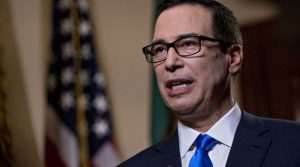Trump Mustn’t Hamper Our Oil and Natural Gas With Tariffs And Quotas

U.S. Secretary of the Treasury Mnuchin has repeatedly said in recent days that the emerging trade compromise with China could pave the way for a $40 to $60 billion increase in annual U.S. energy exports. This should be cause for celebration, but the plan to rebalance the trade deficit with energy exports is being undone by the administration’s own policies. The Department of Commerce Section 232’s Interim Final Rule shouldn’t hurt our natural gas and oil boom by installing steel and aluminum tariffs and quotas.
The tariffs and quotas would increase the cost of new U.S. energy infrastructure and energy production, which is a major problem for our historic ascent to being the world’s premier oil and gas producer, capable of buffering even the most mighty and influential: “Trump’s revenge: U.S. oil floods Europe, hurting OPEC and Russia.” The U.S. is now producing more oil (previously thought to have peaked in 1970) and more gas (previously thought to have peaked in 2005) than it has in the history of the country.
But, tariffs will raise the cost of imported steel by 25%, while quotas will block us from receiving much of the steel required for U.S. energy projects such as pipelines and export facilities around the country – thereby blocking President’s own goals of energy dominance, more jobs, and revamping infrastructure. Upsetting our complex global supply chains of specialty quality steel would be a huge mistake.
Obviously, one common sense measure would be for the U.S. Department of Commerce to grant exclusions for products it determines aren’t even available in the U.S.
Liquefied natural gas (LNG) is the fastest growing traded commodity, and the global market needs a $200 billion investment by 2030. Started in February 2016, U.S. LNG has already reached over 30 nations (about 75% of the importing pool), and the Paris-based International Energy Agency reports that we could become the largest LNG exporter by the mid-2020s. We are destined to become a heavyweight is this increasingly critical business, and we could eventually supply 25-35% of all traded LNG volumes.
As Secretary Mnuchin realizes, of course, all-important China is becoming a blackhole for LNG. Imports will play an increasingly important role in China’s energy portfolio, particularly in the giant cities along the coastal regions that have limited access to pipelines and production from domestic gas fields. Signed in May 2017, the U.S.-China trade deal has opened the door for a contracted wave of U.S. LNG to hit the country, once again buffering the risky influence of Russia that has long sought great power in the Chinese energy market. The good news is that China has been third for imported U.S. LNG, taking in around 17% of our shipments – with so much more to come: “China is preparing to buy a lot more natural gas from the US.”
Getting funding for this second wave of LNG export facilities hasn’t been as easy as the first (e.g., buyers want more of the short-term contracts that banks don’t like so much), so our export business needs helpful policies, not tariffs and quotas that will up their costs.
Oil wise, China has already been importing 400,000 b/d of U.S. crude, or a quarter of our total exports. India too will be seeking more U.S. crude, and the future is unlimited: per capita, 1,330 million Indians consume 0.15 gallons of oil per day, compared to 330 million Americans averaging 2.7 gallons per day.”Texas flood: U.S. oil exports pour into markets worldwide.”
Courtasy : forbes.com
Photo : Bloomberg
[social_warfare buttons=”Facebook,Pinterest,LinkedIn,Twitter,Total”]



